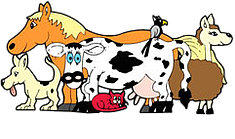Oesophagostomy Tube Feeding
 What is an oesophagostomy tube?
What is an oesophagostomy tube?
An oesophagostomy tube is a small flexible tube that enters the oesophagus or gullet via a small incision through the skin of the neck. It then enters the oesophagus (gullet) through another small incision. Food is thus able to be delivered to the stomach bypassing the mouth and pharynx.
What sort of liquid diet can be used with an oesophagostomy tube?
This depends on the individual needs of the patient. We will discuss this with you but virtually any liquid diet, including home produced diets or commercial diets liquidised in a blender can be used. It is important to ensure that the diet is sufficiently runny so that the tube does not block.
How do I accomplish the feeding and how often?
The liquid food is syringed through the tube three to five times a day depending on the individual circumstances. We will discuss this with you. If you have any queries or concerns please do not hesitate to contact us.
The basic steps are as follows:-
1. If using canned food the correct consistency for syringing through the tube is usually achieved by liquidising the food in a blender with an equal amount of water. Always pour the food through a kitchen strainer when liquidised.
2. Remove the cap from the feeding tube.
3. Using the syringe provided, inject ________ ml of the food into your dog's feeding tube ________ times per day to give a total of ________ ml per 24 hours. It is helpful to inject the food slowly, about 1 ml per second, and to elevate your dog's front feet so the food goes easily into the stomach.
4. When the food has been injected, inject 10 ml of tap water through the tube so food does not remain in the tube and, replace the cap in the tube.
5. Any remaining food should be stored in the refrigerator. Before the next feeding, it should be warmed to body temperature under hot tap water or in a microwave oven. If you heat it in a microwave oven, be sure to thoroughly mix the contents prior to feeding because of uneven heating. Also, always check the temperature prior to feeding to be sure that it is not too hot.
When is the tube removed?
This depends on the condition being treated. We will discuss this with you and advise when to return for tube removal. Removal of the tube is simple and does not require anaesthesia. However, please do not try to remove the tube yourself.
Note: Some measuring devices are measured in millilitres (ml) and others in cubic centimetres (cc). For our purposes, 1 ml equals 1 cc.
© Copyright 2025 LifeLearn Inc. Used and/or modified with permission under license. This content written by LifeLearn Animal Health (LifeLearn Inc.) is licensed to this practice for the personal use of our clients. Any copying, printing or further distribution is prohibited without the express written consent of LifeLearn. This content does not contain all available information for any referenced medications and has not been reviewed by the FDA Center for Veterinary Medicine, or Health Canada Veterinary Drugs Directorate. This content may help answer commonly asked questions, but is not a substitute for medical advice, or a proper consultation and/or clinical examination of your pet by a veterinarian. Please contact your veterinarian if you have any questions or concerns about your pet’s health. Created on Jun 18, 2015.

